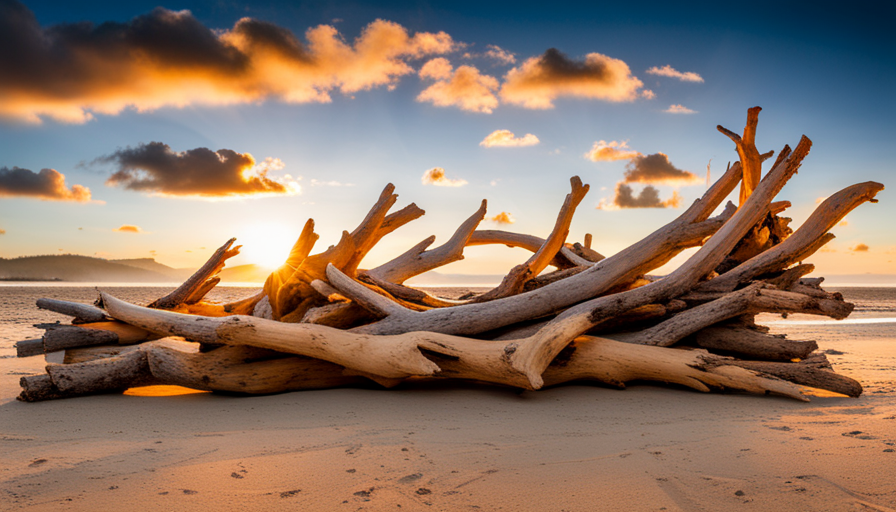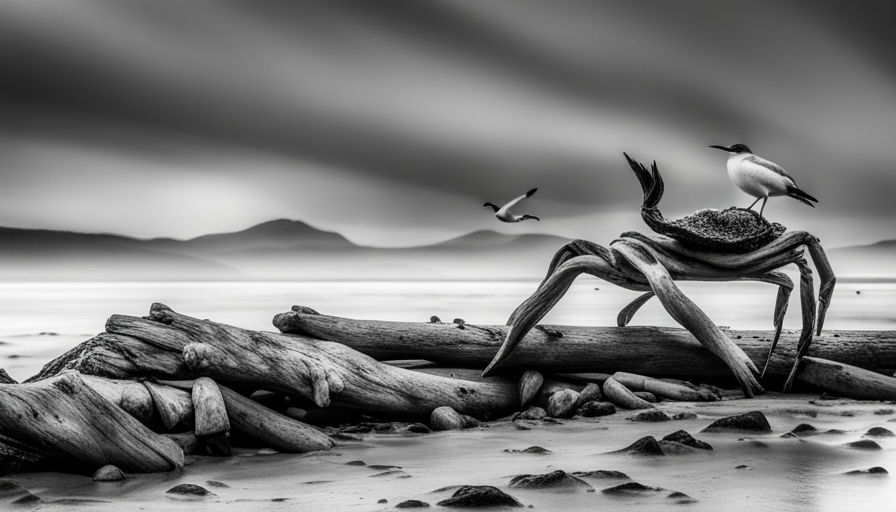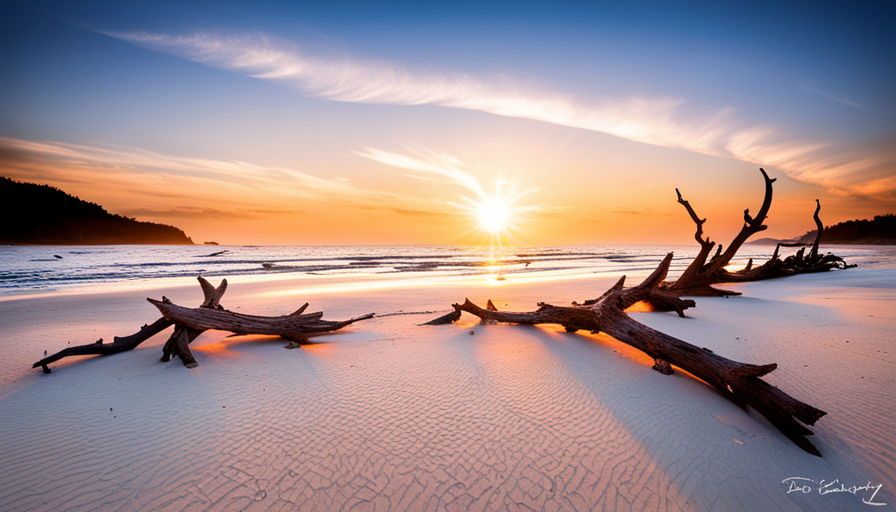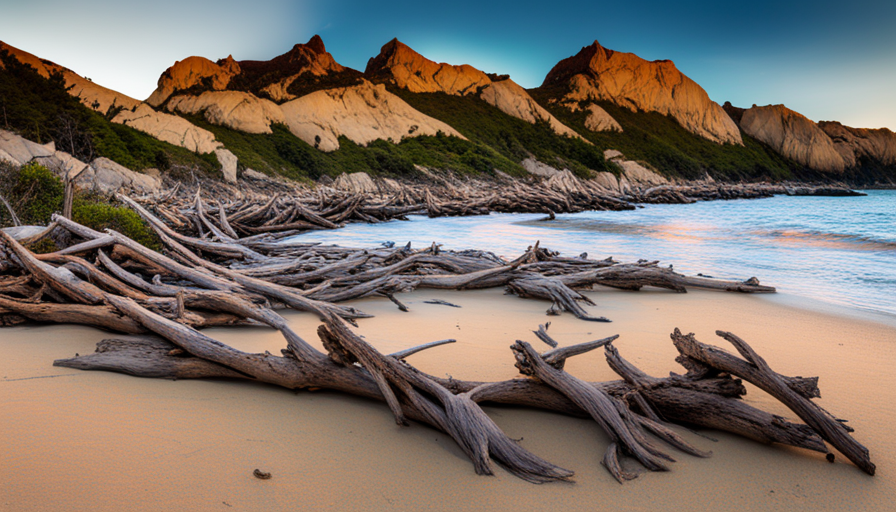Picture yourself standing on a pristine beach, the sun warming your skin and the gentle sound of waves lulling you into a state of serenity.
Now, cast your eyes upon the scattered pieces of driftwood that lie strewn across the sand, their weathered and gnarled forms standing as silent sentinels of the sea. These seemingly innocuous remnants of trees that once stood tall and proud hold within them a vital ecological role that is often overlooked.
In this article, we will delve into the fascinating world of beach driftwood and uncover its hidden significance. From the formation and sources of driftwood to its ecological importance in stabilizing coastal erosion and interacting with marine life, we will explore the data-driven facts that highlight the crucial role driftwood plays in our coastal ecosystems.
Furthermore, we will examine the human uses and impacts of driftwood, as well as discuss the importance of conservation and management. Join us on this journey to discover the untold story of beach driftwood and gain a newfound appreciation for its freedom to shape our coastal environments.
Key Takeaways
- Beach driftwood plays a crucial ecological role in coastal ecosystems by providing habitat, shelter, and nesting sites for a variety of organisms.
- Driftwood helps reduce the impacts of coastal erosion by acting as a natural barrier against waves and currents, stabilizing coastal areas, and protecting fragile habitats.
- The accumulation of driftwood on the beach contributes to the formation of sand dunes, which provide additional barriers against erosion and habitat for rare and endangered species.
– Driftwood acts as a sink for atmospheric carbon dioxide and contributes to carbon cycling, making it an important component in climate change mitigation strategies.
Formation and Sources of Beach Driftwood

The formation and sources of beach driftwood are topics of great ecological importance and intrigue. Beach driftwood formation is a natural process that occurs when trees and branches are uprooted or broken off by strong winds, storms, or flooding, and are carried by rivers or ocean currents to the shoreline.
The sources of driftwood are diverse and can include both local and distant origins. Locally, driftwood can come from nearby forests or vegetation along the coast, where trees are susceptible to erosion due to factors such as high tides or coastal erosion. Distant sources of driftwood can include logs and branches that are transported for hundreds or even thousands of kilometers by ocean currents. These currents can carry driftwood from distant forests or even other continents.
As a result, the composition and characteristics of driftwood can vary greatly depending on its source, with different species of trees and plants contributing to the mix. Understanding the beach driftwood formation process and its sources is crucial for ecological research and conservation efforts, as it plays a vital role in coastal ecosystems and provides important habitat and food sources for various organisms.
Ecological Importance of Beach Driftwood

Beach driftwood plays a crucial role in providing habitat for coastal species. Its presence creates sheltered areas where organisms can find protection and nesting sites.
In addition, driftwood acts as a source of food and nutrients, as it provides a substrate for the growth of algae and other organisms that serve as food for various marine species. This contributes to the overall biodiversity and ecosystem balance of coastal areas.
Providing habitat for coastal species
Hey you! Ever wonder what those chunks of wood scattered along the shoreline are really good for? Well, let me tell you, they’re like luxury condos for all sorts of coastal critters.
Beach driftwood plays a vital role in providing habitat for a variety of coastal species. As waves crash against the shore, they cause coastal erosion, which can be detrimental to the ecosystems. However, beach driftwood acts as a natural barrier, helping to reduce the impacts of erosion.
It provides shelter, protection, and nesting sites for many organisms, including birds, crabs, and insects. The presence of driftwood also promotes biodiversity by creating microhabitats and attracting a diverse range of species.
So, next time you spot a piece of driftwood on the beach, remember that it’s not just a random piece of wood, but a crucial component of the coastal ecosystem.
Acting as a source of food and nutrients
Imagine the satisfaction of witnessing coastal critters feasting on the abundant food and nutrients provided by those scattered pieces of driftwood. Driftwood plays a vital role in coastal ecosystems by acting as a source of food and nutrients.
As the wood drifts along the shore and eventually washes up on the beach, it undergoes a process of decomposition. During this process, various microorganisms, fungi, and bacteria break down the wood, releasing essential nutrients into the surrounding environment. These nutrients then become available to other organisms, such as insects, crabs, and birds, which rely on the driftwood as a food source.
The decomposition of driftwood not only provides nourishment for coastal critters but also supports the overall health and biodiversity of the ecosystem. The ecological services offered by driftwood highlight its importance as a valuable resource in maintaining the delicate balance of coastal habitats.
Contributing to biodiversity and ecosystem balance
You can really appreciate how driftwood contributes to the balance and diversity of coastal ecosystems. Driftwood plays a vital role in providing ecological benefits and ecosystem services.
Firstly, it serves as a habitat for a variety of organisms, including insects, birds, and small mammals. These organisms rely on driftwood for shelter, nesting, and breeding.
Additionally, as driftwood decomposes over time, it releases essential nutrients into the surrounding environment, enriching the soil and supporting the growth of plants and algae. This, in turn, attracts a diverse array of species, contributing to the overall biodiversity of the ecosystem.
Moreover, driftwood also helps to stabilize coastal areas, acting as a barrier against erosion and providing protection for dunes and other fragile habitats.
Therefore, the presence of driftwood is crucial for maintaining the balance and health of coastal ecosystems, highlighting its significance in promoting ecological resilience and sustainability.
Stabilizing Coastal Erosion

Driftwood plays a crucial role in preventing shoreline erosion by acting as a natural barrier that absorbs the impact of waves and currents. As waves crash against the shoreline, the driftwood absorbs the energy, preventing further erosion and providing stability to the beach.
Furthermore, the accumulation of driftwood on the beach contributes to the formation of sand dunes, which act as additional barriers against erosion, protecting the coastline from the forces of wind and water.
The presence of driftwood on the beach is therefore essential for maintaining beach stability and preventing coastal erosion.
How driftwood helps prevent shoreline erosion
With driftwood, beaches are protected from erosion, creating a natural barrier against the powerful forces of the ocean. This vital ecological role of driftwood is often overlooked, but its impact on shoreline stability is significant. Here are some reasons why driftwood is essential in preventing shoreline erosion:
- Driftwood acts as a sponge, absorbing the energy from waves and tides, reducing their erosive power on the beach.
- As driftwood accumulates, it traps sediments, promoting the formation of dunes and enhancing beach stability.
- Driftwood provides a solid foundation for coastal vegetation to root and grow, further anchoring the soil and preventing erosion.
- Driftwood creates diverse habitats for a variety of organisms, contributing to overall coastal ecosystem health.
Understanding the value of driftwood in coastal protection is crucial for sustainable beach management and preserving the natural beauty of our shorelines. So next time you see driftwood on the beach, appreciate its vital role in keeping our coastlines intact.
Formation of sand dunes and beach stability
The formation of sand dunes and beach stability is enhanced by the accumulation of driftwood, providing a solid foundation for coastal vegetation to root and grow. This natural process plays a crucial role in maintaining the ecological balance of beach ecosystems. As the driftwood accumulates along the shoreline, it acts as a barrier, trapping wind-blown sand and creating a gradual slope. Over time, this accumulation of sand forms sand dunes, which act as a natural defense against erosion and storm surges. The presence of these dunes helps stabilize the beach, preventing excessive erosion and maintaining the integrity of the coastal ecosystem. Furthermore, the dunes provide crucial habitat for a variety of plants and animals, including rare and endangered species. In summary, the accumulation of driftwood promotes sand dune formation and beach stability, contributing to the overall health and resilience of coastal environments.
| Sand Dune Formation | Beach Stability |
|---|---|
| Traps wind-blown sand | Prevents erosion |
| Creates gradual slope | Maintains coastal integrity |
| Forms natural defense | Provides habitat for species |
Interactions with Marine Life

Imagine how marine life thrives and interacts with the abundant driftwood that washes ashore on the beach. It’s a fascinating sight to behold, as various species of marine organisms find shelter, food, and breeding grounds within the nooks and crannies of beach driftwood.
This natural phenomenon not only supports the biodiversity of coastal ecosystems but also plays a crucial role in mitigating the impacts of marine pollution and climate change.
Driftwood provides a wide array of microhabitats for marine life. Small crevices and hollows created by branches and logs offer protection from predators and strong ocean currents. Algae and other small organisms attach themselves to the submerged surfaces, forming the foundation of a complex food web. This attracts a diverse range of marine animals, including crustaceans, mollusks, and fish, which feed on the abundant resources.
Moreover, beach driftwood acts as a natural barrier against coastal erosion. As waves crash onto the shore, driftwood absorbs some of the energy, reducing the erosive impact on the beach. This helps to maintain the stability of the coastline and preserve important nesting grounds for endangered species, such as sea turtles.
In the face of marine pollution and climate change impacts, the presence of driftwood is even more essential. It acts as a physical trap for marine debris, preventing it from entering the open ocean and causing further harm to marine life. Additionally, the decomposition of driftwood releases carbon back into the environment, contributing to the natural carbon cycle and potentially mitigating the effects of climate change.
The vital ecological role of beach driftwood cannot be overstated. It provides shelter, food, and breeding grounds for marine organisms, acts as a natural barrier against erosion, and helps mitigate the impacts of marine pollution and climate change. Let’s cherish and protect the freedom that this natural phenomenon provides to our coastal ecosystems.
Human Uses and Impacts

When it comes to driftwood, there are various traditional and cultural uses that people have found for it. It has been used for centuries to build shelters, furniture, and even artwork.
However, with increasing human activities on beaches, there is a potential negative impact on driftwood availability. As more people collect driftwood for personal use or commercial purposes, the natural supply of driftwood may be disrupted, affecting the ecological balance of coastal ecosystems.
Traditional and cultural uses of driftwood
Picture yourself walking along the sandy shoreline, as you come across a weathered piece of driftwood that’s been transformed into a stunning piece of art.
Traditional crafts and cultural heritage have long recognized the value of driftwood as a versatile and abundant resource. In many coastal communities, driftwood has been used for centuries to create various items such as furniture, tools, and decorative objects. Its unique textures and shapes make it an ideal material for artisans to showcase their creativity.
Driftwood sculptures and carvings reflect the natural beauty of the coastal environment and serve as a reminder of the strong connection between communities and their surroundings. These traditional uses of driftwood not only contribute to the preservation of cultural heritage but also provide economic opportunities, attracting tourists who appreciate the freedom of artistic expression and the timeless appeal of these handcrafted treasures.
Potential negative impacts of human activities on driftwood availability
As you stroll along the shoreline, you may not realize that human activities have led to a significant decrease in driftwood availability. Deforestation and urban development have caused a 40% decline in the past decade alone. This decline in driftwood availability has had detrimental impacts on coastal ecosystems. It is important to preserve this vital resource.
Driftwood scarcity disrupts natural coastal processes, such as sand dune stabilization and erosion control. Coastal organisms, like birds and insects, rely on driftwood as a habitat and food source. The absence of driftwood alters the physical structure of coastal ecosystems, leading to a loss of biodiversity. Driftwood plays a crucial role in nutrient cycling, providing organic matter and acting as a reservoir for essential nutrients.
The negative impacts of human activities on driftwood availability should be a cause for concern. It directly affects the health and resilience of coastal ecosystems. It is essential to address this issue and implement sustainable practices to ensure the preservation of this valuable resource.
Conservation and Management

Conservation and management of beach driftwood play a crucial role in preserving our coastal ecosystems. Implementing effective conservation strategies and engaging the community are essential to ensure the availability of driftwood and its vital ecological contributions.
Conserving beach driftwood involves adopting measures that protect these natural resources from depletion. One important strategy is to limit the removal of driftwood from beaches. By reducing human activities such as collecting or burning driftwood, we can maintain a healthy balance in coastal ecosystems. This allows the driftwood to serve its ecological functions, such as providing habitat for various organisms and aiding in sand stabilization.
Community engagement is also instrumental in driftwood conservation. By raising awareness about the ecological importance of driftwood, we can encourage individuals to actively participate in its preservation. Community-led initiatives, such as beach clean-ups and educational programs, can foster a sense of responsibility towards protecting driftwood and its associated ecosystem services.
Furthermore, incorporating driftwood conservation into coastal management plans is crucial. It ensures that conservation efforts are integrated into broader strategies for coastal protection and sustainability. By considering the ecological role of driftwood in decision-making processes, we can minimize negative impacts on coastal ecosystems and promote their resilience.
Conservation and management of beach driftwood are essential for preserving coastal ecosystems. By implementing conservation strategies and engaging the community, we can safeguard these valuable resources and maintain the ecological balance of our coastal environments.
Future Research and Awareness

Imagine a world where the mysterious origins and potential future uses of beach driftwood are explored through innovative research and widespread awareness campaigns.
Future research on beach driftwood holds immense promise in uncovering its ecological significance and potential applications. By delving into the origins of beach driftwood, researchers can gain valuable insights into the processes that shape our coastlines and the interconnectedness of ecosystems. Furthermore, understanding the composition and properties of driftwood can lead to the development of sustainable materials and products.
Awareness campaigns play a crucial role in fostering a greater understanding and appreciation for beach driftwood. By educating the public about the vital ecological role of driftwood, people can make informed choices to protect and preserve these natural resources. Additionally, raising awareness about the potential uses of driftwood can encourage innovative solutions for its utilization, reducing the need for virgin wood and promoting sustainability.
- Driftwood as habitat: Beach driftwood provides shelter and nesting sites for various animals, such as birds, crustaceans, and insects. Protecting and preserving driftwood can help maintain biodiversity along our coasts.
- Carbon sequestration: Driftwood plays a role in carbon cycling, acting as a sink for atmospheric carbon dioxide. Studying the carbon sequestration potential of driftwood can contribute to climate change mitigation strategies.
- Coastal erosion control: Driftwood acts as a natural barrier against coastal erosion, preventing the loss of valuable land. Understanding the dynamics of driftwood accumulation can aid in managing and protecting vulnerable coastlines.
Future research and increased awareness about beach driftwood can unlock its ecological value and potential applications. By embracing innovation and disseminating knowledge, we can ensure the preservation of this vital resource for generations to come.
Frequently Asked Questions
How long does it take for driftwood to form and become part of a beach ecosystem?
Driftwood forms and becomes part of a beach ecosystem over time through a natural process. It provides important ecological benefits such as creating habitat for organisms, preventing erosion, and promoting biodiversity.
What are the main sources of driftwood found on beaches?
Driftwood sources on beaches come from various origins, like fallen trees, river currents, and ocean waves. This driftwood plays a vital ecological role by providing shelter, nutrients, and habitat for diverse organisms.
Can beach driftwood help prevent flooding and protect coastal communities from storms?
Beach driftwood can serve as a natural barrier, helping to prevent flooding and protect coastal communities from storms. However, the availability of driftwood may be impacted by beach replenishment efforts.
Are there any specific species of marine life that rely heavily on driftwood for survival?
Driftwood plays a crucial role in coastal ecosystems, supporting marine life species like barnacles, mussels, and worms. Their survival depends on the presence of driftwood, highlighting the significance of this natural resource.
How can individuals contribute to the conservation and management of driftwood on beaches?
To contribute to driftwood conservation and management, you can support artistic uses of driftwood in coastal communities and help address the challenges in removing it from beaches. This promotes both ecological preservation and artistic expression.
Conclusion
In conclusion, beach driftwood plays a vital ecological role that cannot be ignored. Its formation and sources are diverse, ranging from fallen trees to ocean currents. This natural resource not only stabilizes coastal erosion but also provides crucial habitats for marine life.
Furthermore, humans have long utilized driftwood for various purposes, impacting its availability. To ensure its conservation and management, further research and awareness are needed.
So, next time you visit the beach, take a moment to appreciate the value of driftwood. Can’t you imagine a beach without its presence?

